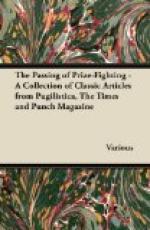[Illustration: “When A man does not look his best.”—No. 4.
When he just begins to realise what A suffering he would have saved himself, if he had only had the COURAGE to say “MEDIUM” Instead of “Hard.”]
* * * * *
Our booking-office.
[Illustration: The Baron’s Retainers, Mesdames Blythe and Gay, giving him the results of their readings.]
In the Christmas Numbers of the numerous picture-papers it is at first rather difficult to discover which is the genuine article illustrated, and which the advertisement, likewise illustrated. In the outside picture of the Christmas Number of The Penny Illustrated Paper, which represents a couple dancing together, I am not yet quite sure that the handsome Hebraic gentleman, dancing with a fair Anglo-Saxon girl, is not assuring his frightened-looking partner that “Epps’s Cocoa is Grateful—Comforting,” as stated in the paragraph immediately beneath the aforesaid picture. On the next page is a sad illustration entitled, “The Curse of Revenge. Lost to Human Aid.” which turns out to be not a Christmas story at all, but an advertisement for Fruit Salt. Then opposite this commences a story by George R. Sims; and at the foot of this page some one replies, “Mr. Doolan! There’s no one of that name here now, Sir.” Whereupon, being interested, the reader turns over page 1 to find at the head of page 2, not the continuation of the above interesting story in the shape of some remark on the part of the inquirer, nor any account of what happened after this reply had been given, but simply “Benson’s Watches” followed by “Fry’s Chocolate,” then a picture (not an advertisement) facing that, and then on page 4 the remainder of the dialogue. It doesn’t much matter perhaps, as the excitement aroused by the story is not violent, and the mistake of giving somebody else’s card for your own does not occur here for the first time as the motive of a plot. Cuthbert BEDE’s name is to a “Christmas Carol,” and Mr. John LATEY’s to a dramatically told tale called “Mark Temple’s Trial,” in which the imaginary heroine pays a visit to a very real person of the name of Madame KATTI lanner, whose pupils are represented as all assembled, with bouquets and posies, to do honour to the birthday of their “well-loved mistress,” who is at the same time, “the acknowledged mistress of the choreographic art.” In this story, the author is to be complimented on his invention of the name, “Lord Morgagemore” as an ancient looking and highly aristocratic Irish title.




